I bet many of you have seen Ric Viers featured in this blog several times. But do you know how he get started? What are thier influences? Philosophy?Here’s an interview I had with him, where we discussed all those things and more!
Designing Sound: How did you get started and how has been the evolution of your career?
Ric Viers: That’s a funny story. I started off as a location sound mixer for television. This was not my intended career path. I graduated from Full Sail University with the intention of being a writer / director. I moved back to Detroit, but couldn’t seem to find any work. So, I looked for ‘back doors’ into the business. Despite the fact that sound was not my main focus at Full Sail, I felt that I could get a job as a sound engineer because their film curriculum had a strong concentration of sound courses.
I knocked on a few doors. Actually, I knocked on a lot of doors. No one was hiring. I quickly found out that freelance work was in abundance at the time, so I looked for companies that were willing to let a newbie on their shoots. Fortunately, a great company called KDN was willing to take the risk on me. This led to several years of location sound work for me.
I was constantly trying to better my craft and would often borrow equipment from KDN on the evenings and weekends to really understand the gear and thus, make me a better recordist. In the mean time, I was producing my own film shorts on Mini DV cameras and cutting them on my home computer. This is very common today, but back then this was a brand new concept. Digital video and audio was just starting to empower the little guys and began to level the playing field.
The one thing that I realized was missing from my productions was sound effects. For Christmas one year, my wife bought me several sound effects CDs. These were consumer-level CDs and weren’t very good, but it gave me something to start experimenting with for my films. I received a sample CD from a ‘professional’ sound effects company and was very disappointed in the quality. These sounds didn’t meet my expectations for what I thought should be professional and I certainly wasn’t going to spend any money on buying them. What to do?
I remember saying to myself “If this is what is considered to be professional, I would be better off recording my own sound effects.” So, that’s what I did. I borrowed a shotgun mic (Sennheiser MKH-416) along with a DAT recorder (Sony TCD-D10) from KDN and headed out into the field. I had no idea how significant that decision would be. It was an impulsive decision that led to a lifelong career.
I absolutely loved recording! It was sonic photography! I recorded for about a year, until one day my hard drive became full (which was hard to believe, since I had a whopping 2Gb hard drive.) I was cleaning out my hard drive when I discovered that I had over a thousand sound effects that I had recorded. I figured someone out there would probably be interested in buying this stuff.
I jumped on Yahoo (Google wasn’t around back then) and searched for “Sound Effects Companies”. The first company that came up was a sound effects company located in Canada. So, without even thinking about it, I sent them a demo. I received a call the next week from the owner. He was very impressed with my work and told me that the stuff I sent was “cleaner and better produced than the work he gets from guys in Hollywood”. I was shocked. I was using a spare bedroom in my apartment to create material that would impress a mega sound effects company! He commissioned me right on the spot to record a library of impact sound effects.
And so I did. Keep in mind, I was still trying to pursue a career as a filmmaker. I figured I could create sound effects libraries on the side until the right opportunity came along. But, something happened the day I received the final product: a professionally manufactured CD that had my name in the credits! I felt empowered. I thought to myself “Maybe I can do this?” “Maybe I could become a sound designer?”
To date, I’ve worked on over six hundred different sound effects products for companies around the world including Blastwave FX, a sound effects label that I started back in 2007.
DS: What was your first gig like?
RV: I was paranoid. I was completely freaked out and had no confidence in what I was doing. I was scared that the sound effects I was producing wouldn’t be up to par with what they were looking for. In hind sight, this was probably the best thing that could have happened to me. I was very meticulous during the recording and editing processes. I made sure that every sound was perfect – no defects, no background noise. I wanted each sound to be only the sound effect, nothing else. After all, if the work wasn’t the best it could be, I might not get another gig!
I sent in my first draft or preliminary master. A week later, I received notes on some changes and additions they wanted. I followed their directions and learned a lot based on their comments. Two rounds of changes later, they went to print with the project. Upon receipt of the final product, I received a contract for the next project. Thus, began my career.
DS: What/who inspires/influences you?
RV: That’s a big question! I grew up on the Star Wars and Raiders films, so Ben Burtt was probably the first sound designer to give me an understanding of cool sound effects. There are certainly other big influences. I’m a huge Gary Rydstrom fan. I love all of his work. His approach is very thought out and calculated, but he has no reservations about using simple props to make great sounds. His work is sophisticatedly simple.
Continuing with the Skywalker greats, I’m a big fan of Randy Thom as well. He’s very purposeful in his work and seems to do everything for a reason. Plus, he’s very wise and knows his craft. I’m the grasshopper to his Master Po. Scott Gershin, Alan Howarth, Mark Mangini, Charles Maynes and Ren Klyce have also been big influences.
Nowadays, I’m pretty blown away with the undiscovered newcomers. The sound design challenges that Blastwave FX started has led to a new fad of challenges that allow the new guys to take a crack at design work. Some of the results are amazing! I listen to the entries and think to myself “why aren’t these guys working at a major studio?” It’s always nice to hear new and fresh perspectives on sound.
I can’t really put my finger on what I think good sound design is. I think you just know it when you hear it. It’s kind of like music. There are tons of artists out there but only a few have the “it” factor. You can’t define “it”, but you know “it” when you hear “it”.
DS: Could you tell us more about your approach to field recording?
RV: I’m certainly a boy scout when it comes to field work, in that I’m always prepared. I always bring extra recorders, mics, cables, etc., especially when I’m working great distances from the studio. I guess the idea is that I want to focus on the creative process and not the gear. For me, gear should be transparent. If you have to deal with equipment issues, then you spend less time on what is important – recording.
The guys at the Chop Shop will tell you that I suffer from severe OCD, especially in my work. Background noise drives me nuts, so I try to find the quietest locations to work. Smart phone apps that have map software with aerial views are a big help in finding spots to record that are far from traffic and factories. Of course, even there you’ll have planes!
Despite all of the headaches, field recording can be a blast! It’s always an adventure and there’s always something new to discover and record. At the end of the day, if you’re not having fun, then you’re doing something wrong!
DS: What is the biggest lesson you’ve learned from your vast experience in that field?
RV: Everything I know about field recording I learned from the U.S. Marine Corps mantra “Improvise, Adapt and Overcome”. There’s so much unpredictability in field recording that you can easily go crazy if you don’t learn to roll with the punches. Most of the time, you come back with lots of stuff you didn’t plan on finding and very little of what you intended to record. That’s okay, as long as you come back with something.
DS: What are your favorite tools for working in the studio and the field?
RV: The Chop Shop has about eighty microphones, but we always seem to gravitate to about a half dozen or so. Microphones are like guitars – everyone has their favorites. I’m a huge Rode Microphones fan. I think it’s funny that people automatically assume that expensive equals better. I have friends in Hollywood that work on major films that are shocked at the quality and price difference in Rode’s products. No, this isn’t a Rode commercial. The point is to listen to the microphone (regardless of the brand or price point); don’t just read the specs on the box.
In the studio, I master everything in Sony’s Sound Forge. I absolutely love this program. It’s very robust and allows me to shape, trim, process, and save the file anyway I want. Plus, it’s fast! The latest versions allow for multi channel files which make surround sound work a breeze. You can load it up on a laptop and use it as a multi track recorder in the field, but of course, you have to deal with the sound of the laptop’s fan.
I can’t stress enough how technique is more important than gear. You can create great sounds with “okay” equipment if you use great techniques. But, you can’t create greats sound with great equipment if you use poor techniques. Of course, if you start off with poor gear, you will almost always get poor sound.
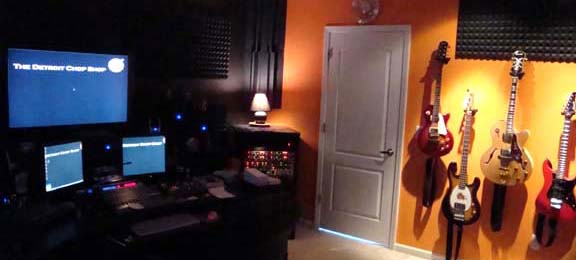
DS: What do you love the most about sound design?
RV: For me, it’s about creating. I love the creation element. It’s an art form, like music. I’m passionate about finding new ways to make sound effects. I’m always amazed at the impact sound can bring to a scene.
I certainly have a fetish for science fiction and horror sounds. I’m not sure why. It could be because these sounds don’t occur naturally and have to be created using mental elbow grease and a healthy does of plug-ins. But, it’s probably because these are the types of films I grew up watching. I’m also a big fan of larger-than-life sounds like crashes and production elements.
While it can be fun to record cars, planes, door bells and sirens, I’d rather be in the field recording elements that I can use to create something that no one has heard before. Building, layering and shaping the sounds of creatures, haunted environments and space stations is what gets me up in the morning. Nobody sits in the studio listening to door bell sound effects and says “Wow! That’s cool!” I like to go for the “wow” factor in my work.
DS: I heard you’re going to release another “Bible” of sound, after the successful Sound Effects Bible, which I personally love. Could you talk us about that next book?
RV:Nope. My publisher won’t let me. Sorry. And no, it won’t be called the Sound Effects Koran.
DS: You do a lot of production sound as well as dialogue recording, Foley, sound design, etc. Is there any favorite for you? What you find interesting about doing all those different crafts?
RV: I’m a rolling stone. I hate sitting still and I don’t like doing the same thing for too long. Working on a project that allows me to dabble in all of these various crafts during a project is a breath of fresh air. The finalization of a project is my favorite part. Whether it’s creating the demo for a sound library or sitting with the director during the final mix, I love watching all of the elements come together.
And what about Blastwave FX? Could you tell us how you get started with it? What’s coming this year there?
RV: Blastwave FX is basically an independent sound effects label that got big fast. We are now one of the top three publishers of sound effects in the world. The vision is to provide higher quality and more useful sound design tools. I was frustrated with the ‘standard’ sound effects libraries and wanted to shake things up a bit. Up until Blastwave FX, my team had created sound libraries for virtually every company that puts out sound effects, including the majors. I knew there was room for innovation, but the big dogs didn’t seem interested in moving forward with new ideas. Most libraries out there are ‘stock’ sound effects libraries. I don’t want that for Blastwave FX. You can buy a picture (stock sounds) or you can buy paint to create your own work of art (Blastwave FX).
It’s humbling to find that major film studios, television networks and video game companies are using our libraries. We’ve certainly caught the attention of some of the other sound effects libraries out there and it’s kind of funny to watch the old guard try to keep up. But, I’m not worried. My goal isn’t to be the best sound designer in the world; my goal is to educate and empower up-and-coming sound designers so that they can be the best sound designers. Hopefully, The Sound Effects Bible and Blastwave FX will give them some of the tools they need to achieve their vision.
DS: What are you currently working on? What’s next for Ric Viers?
RV: No rest for the wicked! We’ve got a couple of things in the works for this year. Stay tuned for a big Blastwave FX announcement this month! Also, you can check out The Sound Effects Bible’s Facebook Page (www.facebook.com/sfxbible) for the latest.
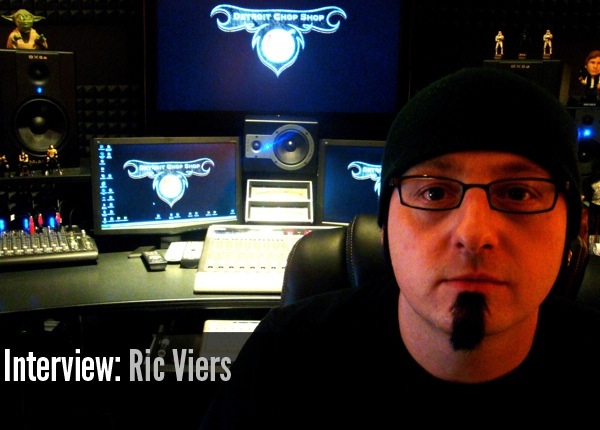
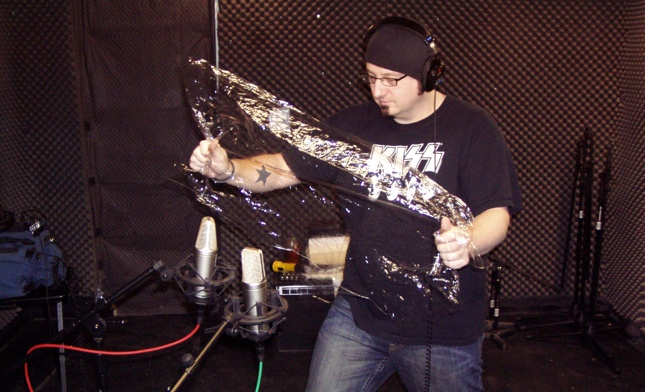
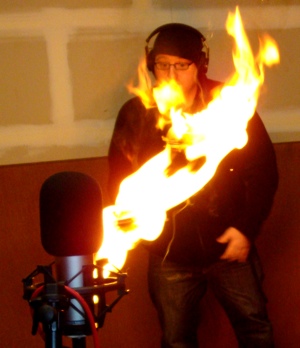

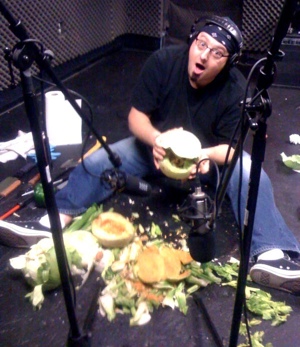
[…] you have the opportunity to do your own questions our special guest Ric Viers. Please read the exclusive interview first. Maybe you can find your answer […]